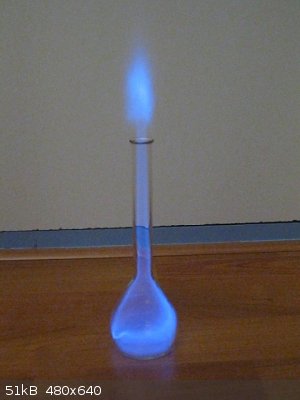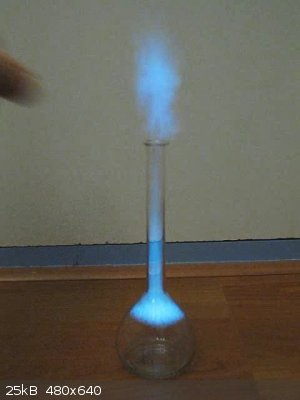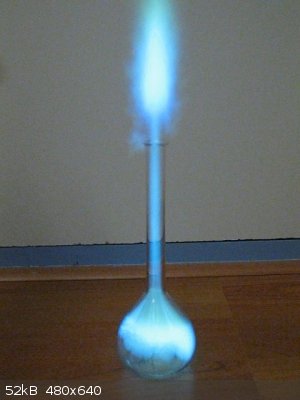woelen
Super Administrator
        
Posts: 7977
Registered: 20-8-2005
Location: Netherlands
Member Is Offline
Mood: interested
|
|
Near-explosions in flasks
Right now, I am experimenting with flames, and how they behave in confined spaces, tubes, and that kind of things. The following was so nice, that I
made a webpage about it:
http://woelen.homescience.net/science/chem/exps/raw_material...
Some pictures:
This is the result of burning alcohol in a flask:

When some boric acid is added, then the color shifts to cyan:


This is quite a cool experiment and it only requires alcohol (and optionally some boric acid). be careful though, don't confine the vapor too much,
then the near-explosion may become a real explosion!
Edit(woelen): Made link and pictures working again.
[Edited on 30-7-16 by woelen]
|
|
|
12AX7
Post Harlot
    
Posts: 4803
Registered: 8-3-2005
Location: oscillating
Member Is Offline
Mood: informative
|
|
Heh, I've done that with plastic bottles before. There is very little heat in a thin alcohol flame, so it doesn't melt. A few repeats will heat up
the vessel though. Most obviously, one might do it with a mostly-empty bottle of rubbing alcohol, but it can also be done with propane.
Very beautiful shots of the flame!
Tim
|
|
|
chemkid
Hazard to Others
  
Posts: 269
Registered: 5-4-2007
Location: Suburban Hell
Member Is Offline
Mood: polarized
|
|
I have done the same using rubbing alcohol in bottles before. In addition i have done the above experiments. However, i used denatured alcohol.
Ethanol/methanol mix, correct? First, i got a yellow flame when i ignited the denatured alcohol. And second, upon the addition of boric acid i yielded
a bright green flame. Is this all because of the methanol? If so how could i remove the methanol. I would rather not distill because i have no proper
equipment, but i probably could if necessary.
Chemkid
|
|
|
MagicJigPipe
International Hazard
    
Posts: 1554
Registered: 19-9-2007
Location: USA
Member Is Offline
Mood: Suspicious
|
|
If you don't even have a simple distillation setup, you can't remove MeOH from EtOH assuming your lack of distillation equipment is indicative of your
lack of other equipment/reagents. I know it's way more expensive but if you want pure ethanol (95%) without hard work, go to the liquor store. Then
I've heard you can make it near absolute with 3a molecular sieves.
Woelen, that has got to be one of the coolest pictures I have ever seen. I like the sound it makes. At least in a plastic bottle because I never
wanted to risk my glassware.
[Edited on 25-11-2007 by MagicJigPipe]
"There must be no barriers to freedom of inquiry ... There is no place for dogma in science. The scientist is free, and must be free to ask any
question, to doubt any assertion, to seek for any evidence, to correct any errors. ... We know that the only way to avoid error is to detect it and
that the only way to detect it is to be free to inquire. And we know that as long as men are free to ask what they must, free to say what they think,
free to think what they will, freedom can never be lost, and science can never regress." -J. Robert Oppenheimer
|
|
|
YT2095
International Hazard
    
Posts: 1091
Registered: 31-5-2003
Location: Just left of Europe and down a bit.
Member Is Offline
Mood: within Nominal Parameters
|
|
Wow, Woelen those are Very nice! they remind me a little of the Blue Jet phenomenon when some Lightning strikes are seen from space.
what speed were you filming at?
\"In a world full of wonders mankind has managed to invent boredom\" - Death
Twinkies don\'t have a shelf life. They have a half-life! -Caine (a friend of mine)
|
|
|
coal
Harmless

Posts: 15
Registered: 13-10-2007
Member Is Offline
Mood: No Mood
|
|
i did this in a 2L RBF with methanol. made a beautiful 'sheet' of blue flame that worked its way to the bottom of the flask quite slowly. a very
pretty thing to see. shame it doesn't have much of a practical use :/
|
|
|
woelen
Super Administrator
        
Posts: 7977
Registered: 20-8-2005
Location: Netherlands
Member Is Offline
Mood: interested
|
|
I made the pictures at a frame rate of 30 images/second. That framerate is sufficient for making nice videos of all kinds of phenomena. The camera I
have also can make 60 frames per second, but only at 320x240 resolution.
I agree with coal that this kind of stuff has no direct practical application, but does that matter? Actually, most of the stuff on sciencemadness
does not have practical application, isn't it? 
I also added an experiment with a long glass tube on the webpage and an experiment with methanol and boric acid during daytime. The physical effect is
similar, but the visual effect is quite different:
http://woelen.homescience.net/science/chem/exps/raw_material...

[Edited on 30-7-16 by woelen]
|
|
|
bereal511
Hazard to Others
  
Posts: 162
Registered: 9-8-2005
Location: Madison, WI
Member Is Offline
Mood: No Mood
|
|
That has to be the most intriguing flame effect. Have you tried with longer tubes? It would be really interesting to see the flame travel through
some kind of glass/plastic maze of some sort, then somehow change colors here and there.
As an adolescent I aspired to lasting fame, I craved factual certainty, and I thirsted for a meaningful vision of human life -- so I became a
scientist. This is like becoming an archbishop so you can meet girls.
-- Matt Cartmill
|
|
|
12AX7
Post Harlot
    
Posts: 4803
Registered: 8-3-2005
Location: oscillating
Member Is Offline
Mood: informative
|
|
Ha, it looks like chromatography running!
Er, gas chromatography of hot radicals, anyone? Maybe not...still looks nice though 
Tim
|
|
|
UnintentionalChaos
International Hazard
    
Posts: 1454
Registered: 9-12-2006
Location: Mars
Member Is Offline
Mood: Nucleophilic
|
|
I've done a similar thing with long flexible plastic tubing except you just need a jet type lighter (preferably a stick lighter). You need to wedge
the tip of the lighter in the tubing and then let gas flow for a a while (depends on tube length, probably in the range of 10-15 seconds for a foot or
two. When full, spark the gas (but keep adding more) and watch a little blue fireball zip through the tubing, occasionally slowing down for whatever
reason and then leaping out the end of the tube
Department of Redundancy Department - Now with paperwork!
'In organic synthesis, we call decomposition products "crap", however this is not a IUPAC approved nomenclature.' -Nicodem
|
|
|
nitro-genes
International Hazard
    
Posts: 1048
Registered: 5-4-2005
Member Is Offline
|
|
When the diameter of the combustion chamber and exhaust are in the right proportion, you get the phenoma thats used in valveless pulsejet engines. The
mass inertia of the expelled exhaust gasses creates a short period of low pressure in the combustion chamber, which allows fresh air to be sucked in
again, before the flame has died out completely. It can easily be recreated with a glass jar and some methanol. Ethanol works as well, though not as
good as methanol. 
http://www.youtube.com/watch?v=AePLpM5SnqE
Currently working on a valveless pulsejet design, the original design with valves from 0.05 mm spring steel wore out pretty fast before the valves
start to bend due to the high temperature. Sounds amazing though...
|
|
|
vulture
Forum Gatekeeper
    
Posts: 3330
Registered: 25-5-2002
Location: France
Member Is Offline
Mood: No Mood
|
|
A little SrCl2 or CuCl2 in methanol also works very well for producing intensely colored flames.
One shouldn't accept or resort to the mutilation of science to appease the mentally impaired.
|
|
|
JohnnyGenocide
Harmless

Posts: 7
Registered: 23-11-2007
Member Is Offline
Mood: No Mood
|
|
Nice images. Give us some details regarding the photographic techniques. I'm having to document some similar images and I am not a professional
photographer (my wife is but I'm determined to take the pictures myself).
|
|
|
MagicJigPipe
International Hazard
    
Posts: 1554
Registered: 19-9-2007
Location: USA
Member Is Offline
Mood: Suspicious
|
|
Just get a digital camera and take a picture. I would say just use one that doesn't have that annoying delay. Disposable cameras are best for quick
pictures though.
Or a digital video camera would be great too. Or a dig camera with video.
Pretty much anything. Just time it right and take the picture. You don't have to be a professional photographer!
"There must be no barriers to freedom of inquiry ... There is no place for dogma in science. The scientist is free, and must be free to ask any
question, to doubt any assertion, to seek for any evidence, to correct any errors. ... We know that the only way to avoid error is to detect it and
that the only way to detect it is to be free to inquire. And we know that as long as men are free to ask what they must, free to say what they think,
free to think what they will, freedom can never be lost, and science can never regress." -J. Robert Oppenheimer
|
|
|
woelen
Super Administrator
        
Posts: 7977
Registered: 20-8-2005
Location: Netherlands
Member Is Offline
Mood: interested
|
|
MagicJigPipe, in this case, you are wrong. With hand-timing you definitely won't succeed in making pictures like this  . Situations like this only last for tens of milliseconds and you're a very smart boy
if you can hand-time such a thing. . Situations like this only last for tens of milliseconds and you're a very smart boy
if you can hand-time such a thing.
You don't have to be a professional photographer, nor do you need professional equipment, in order to make pictures like this, but it definitely
requires some care and good preparation. With just some adhoc shooting you won't get good results.
I made this with a digital camera, which has video recording capabilities at 640x480 resolution and 30 frames per second, a Canon Powershot A620. I
use a camera stand with screw connection, attach the camera to this and then switch on recording.
Lighting also is fairly critical. Daylight is too bright, a big tungsten lamp also. But a completely darkened room also is not suitable, because that
makes the recording device of the camera very slow and extremely noisy. Getting the right pictures requires a little trial and error. If you do a lot
of photography, then you'll get some feeling for this and the amount of trial and error can be greatly reduced.
If you take into account the things, written above, then things are not that special. Try to get some experience in making pictures of experiments,
and also take care of composition and background. A mistake, made by many photographers is that the background has many little irrelevant details in
it, and that distracts from the main subject.
[Edited on 12-12-07 by woelen]
|
|
|
12AX7
Post Harlot
    
Posts: 4803
Registered: 8-3-2005
Location: oscillating
Member Is Offline
Mood: informative
|
|
My pet peeve with ameteur photographers is focus. Often, people believe that, by getting closer to an object, they can get more detail on it than at
the correct focal length. This is exceptionally common with low quality cameras, which are fixed at, say, 6" macro, 3'-infinity normal.
Another error, more common today than ever, is the posting of megapixel images. If you can't say it in fewer than 600 pixels width and under half a
megapixel total, you should reconsider what you're posting. Quality images can easily be under 50kB (Woelen's above are under 45k!  ), so a rather long webpage about a single subject might contain, oh, 10-20 pictures
totalling under a megabyte total download. My entire website is about 14MB and contains about 550 images. ), so a rather long webpage about a single subject might contain, oh, 10-20 pictures
totalling under a megabyte total download. My entire website is about 14MB and contains about 550 images.
Tim
|
|
|